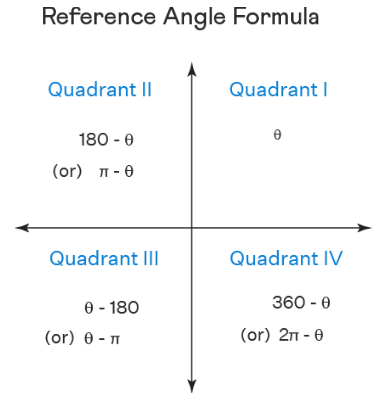How to Find Reference Angles?
The reference angle is the smallest angle you can make from the terminal side of an angle with the \(x\)-axis. In this step-by-step guide, you will learn more about reference angles.

Related Topics
Step-by-step guide to finding reference angles
The reference angle is the smallest possible angle formed by the terminal side of the given angle with the \(x\)-axis. It is always an acute angle (except when it is exactly \(90°\)). A reference angle is always positive regardless of which side the axis is falling.
To draw a reference angle for an angle, specify its end side and see at what angle the terminal side is closest to the \(x\)-axis.
Rules for reference angles in each quadrant
Here are the reference angle formulas depending on the angle quadrant:

Steps to find reference angles
The steps to find the reference angle of an angle are as follows:
- Find the coterminal angle of the given angle that lies between \(0°\) and \(360°\).
- If the angle of step \(1\) is between \(0\) and \(90°\), that angle itself is the reference angle of the given angle. If not, then we need to check if it is close to \(180°\) or \(360°\) and how much.
- The angle from step \(2\) is the angle reference angle.
Reference Angles – Example 1:
Find the reference angle of \(\frac{8π}{3}\) in radians.
Solution:
First, find the coterminal angle. To find its coterminal angle subtract \(2π\) from it.
\(\frac{8π}{3} – 2π = \frac{2π}{3}\)
This angle is not between \(0\) and \(\frac{π}{2}\). Therefore, it is not the reference angle of the given angle. Then check whether \(\frac{2π}{3}\) is close to \(π\) or \(2π\) and by how much.
\(\frac{2π}{3}\) is close to \(π\) by \(π – \frac{2π}{3} = \frac{π}{3}\). Therefore, the reference angle of \(\frac{8π}{3}\) is \(\frac{π}{3}\).
Exercises for Reference Angles
Find the reference angle.
- \(\color{blue}{\frac{31\pi }{9}}\)
- \(\color{blue}{-250^{\circ }}\)
- \(\color{blue}{-\frac{25\pi }{18}}\)

- \(\color{blue}{\frac{4\pi }{9}}\)
- \(\color{blue}{70^{\circ }}\)
- \(\color{blue}{\frac{7\pi }{18}}\)
Related to This Article
More math articles
- Best Laptop for Math Students In 2024
- What is the Best Laptop for College Students?
- Bingo Breakdown: Patterns, Probabilities, and Multi-Card Play
- Ratio, Proportion and Percentages Puzzle – Critical Thinking 7
- 3rd Grade Common Core Math FREE Sample Practice Questions
- Top Tablets for Online Math Teaching
- What are the Undefined Limits: Defining from Tables and Graphs
- Number Properties Puzzle – Challenge 3
- 10 Most Common 3rd Grade MAP Math Questions
- FREE 3rd Grade MAP Math Practice Test


















What people say about "How to Find Reference Angles? - Effortless Math: We Help Students Learn to LOVE Mathematics"?
No one replied yet.